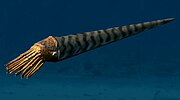The Ordovician (/ɔːrdəˈvɪʃi.ən, -doʊ-, -ˈvɪʃən/ or-də-VISH-ee-ən, -doh-, -VISH-ən) is a geologic period and system, the second of six periods of the...
82 KB (7,847 words) - 17:09, 22 November 2024
Cap Late D O–S The Late Ordovician mass extinction (LOME), sometimes known as the end-Ordovician mass extinction or the Ordovician-Silurian extinction, is...
102 KB (11,112 words) - 04:51, 11 November 2024
The Early Ordovician is the first epoch of the Ordovician period, corresponding to the Lower Ordovician series of the Ordovician system. It began after...
41 KB (4,055 words) - 18:17, 11 November 2024
The Late Ordovician, also called the Upper Ordovician by geologists, is the third and final epoch of the Ordovician period. At this time, Western and Central...
5 KB (466 words) - 00:08, 21 November 2024
K–Pg Tr–J P–Tr Cap Late D O–S The Cambrian–Ordovician extinction event, also known as the Cambrian-Ordovician boundary event, was an extinction event that...
7 KB (792 words) - 18:11, 8 August 2024
geologic period and system spanning 24.6 million years from the end of the Ordovician Period, at 443.8 million years ago (Mya), to the beginning of the Devonian...
59 KB (5,834 words) - 02:26, 14 November 2024
Paleozoic (section Ordovician Period)
subdivided into six geologic periods (from oldest to youngest), Cambrian, Ordovician, Silurian, Devonian, Carboniferous and Permian. Some geological timescales...
35 KB (3,712 words) - 20:34, 18 November 2024
Trilobite (section Ordovician)
appearing in the Ordovician include: Cyclopyge (Early to Late Ordovician) Selenopeltis (Early to Late Ordovician) Parabolina (Early Ordovician) Cheirurus (Middle...
111 KB (11,945 words) - 10:34, 22 November 2024
The Great Ordovician Biodiversification Event (GOBE), was an evolutionary radiation of animal life throughout the Ordovician period, 40 million years after...
36 KB (3,723 words) - 02:48, 16 September 2024
The Ordovician meteor event was a dramatic increase in the rate at which L chondrite meteorites fell to Earth during the Middle Ordovician period, about...
8 KB (719 words) - 04:36, 26 September 2024
Hirnantian glaciation (redirect from Late Ordovician glaciation)
Ice Age (EPIA), the Early Paleozoic Icehouse, the Late Ordovician glaciation, or the end-Ordovician glaciation, occurred during the Paleozoic from approximately...
62 KB (6,874 words) - 08:25, 11 November 2024
Cambrian (section Cambrian–Ordovician boundary)
Ediacaran period 538.8 Ma (million years ago) to the beginning of the Ordovician Period 485.4 Ma. Most of the continents lay in the southern hemisphere...
89 KB (9,316 words) - 06:11, 22 November 2024
(Ordovician) Chlamydosphaeridia (Ordovician) Comasphaeridium (Ordovician) Coronitesta (Ordovician) Coryphidium (Ordovician) Costatilobus (Ordovician)...
20 KB (1,799 words) - 20:45, 10 September 2024
[citation needed] As such, it's not until the Ordovician that the first crown-group members arise. By the Ordovician period the gastropods were a varied group...
48 KB (5,042 words) - 16:02, 22 November 2024
point been present around Earth during the Ordovician period. These rings may have formed during the Ordovician impact spike approximately 466 million years...
6 KB (612 words) - 11:30, 9 November 2024
Phanerozoic (section Ordovician Period)
into the super-continent Gondwana. The Ordovician spans from 485 million to 444 million years ago. The Ordovician was a time in Earth's history in which...
61 KB (6,170 words) - 14:37, 7 November 2024
and extending southwest to Longford and south to Navan is a province of Ordovician and Silurian rocks, with similarities to the Southern Uplands province...
211 KB (21,156 words) - 18:29, 21 November 2024
Sacabambaspis (category Ordovician jawless fish)
Sacabambaspis is an extinct genus of jawless fish that lived in the Ordovician period. Sacabambaspis lived in shallow waters on the continental margins...
9 KB (918 words) - 11:55, 3 October 2024
; Owen, A. W. (2002), Palaeobiogeography and Biodiversity Change: The Ordovician and Mesozoic–Cenozoic Radiations, Geological Society Special Publication...
303 KB (26,903 words) - 12:59, 19 November 2024
the Mexican amber by García-Villafuerte (2018). Redescription of the Ordovician malacostracan Wuningia multisegmenlata is published by Lin (2018). A member...
177 KB (9,341 words) - 20:36, 18 November 2024
Caledonian orogeny (category Ordovician orogenies)
Europe. The Caledonian orogeny encompasses events that occurred from the Ordovician to Early Devonian, roughly 490–390 million years ago (Ma). It was caused...
62 KB (7,538 words) - 10:00, 29 September 2024
Orthoceras (category Ordovician cephalopods)
Orthoceras is a genus of extinct nautiloid cephalopod restricted to Middle Ordovician-aged marine limestones of the Baltic States and Sweden. This genus is...
5 KB (437 words) - 01:31, 30 October 2024
(Silurian or younger). It was formed in a marine environment in the Late Ordovician period. The meteorite is estimated between 50 and 90 million tons and...
7 KB (561 words) - 08:26, 17 May 2024
Geological history of Earth (section Ordovician period)
Iapetus Ocean and Khanty Ocean. The Ordovician period started at a major extinction event called the Cambrian–Ordovician extinction event some time about...
55 KB (6,434 words) - 06:34, 11 November 2024
coast Ordovician genus, in prior times it was employed as a general name given to all straight-shelled nautiloids that lived from the Ordovician to the...
37 KB (3,465 words) - 01:30, 15 November 2024
Representatives of this genus have been found in the Upper Ordovician of the Czech Republic. Biogeography of Ordovician bryozoans. Michael E Tuckey, Palaeogeography...
1 KB (84 words) - 20:14, 18 November 2024
malacology known as teuthology. Cephalopods became dominant during the Ordovician period, represented by primitive nautiloids. The class now contains two...
139 KB (15,486 words) - 14:22, 6 November 2024
in the Middle Ordovician period. If rocks of unknown age are found to have traces of E. pseudoplanus, they must have a mid-Ordovician age. Such index...
102 KB (10,183 words) - 12:35, 2 November 2024
(Ordovician) Actinotrypidae (Carboniferous-Permian) Anolotichiidae (Ordovician) Botrylloporidae (Ordovician-Devonian) Ceramoporidae (Ordovician-Devonian)...
3 KB (236 words) - 19:39, 16 December 2023
to the present. They diversified profusely in the Ordovician, and are most common in the Ordovician, Silurian and Devonian marine deposits of the Paleozoic...
5 KB (581 words) - 00:12, 29 May 2021





















